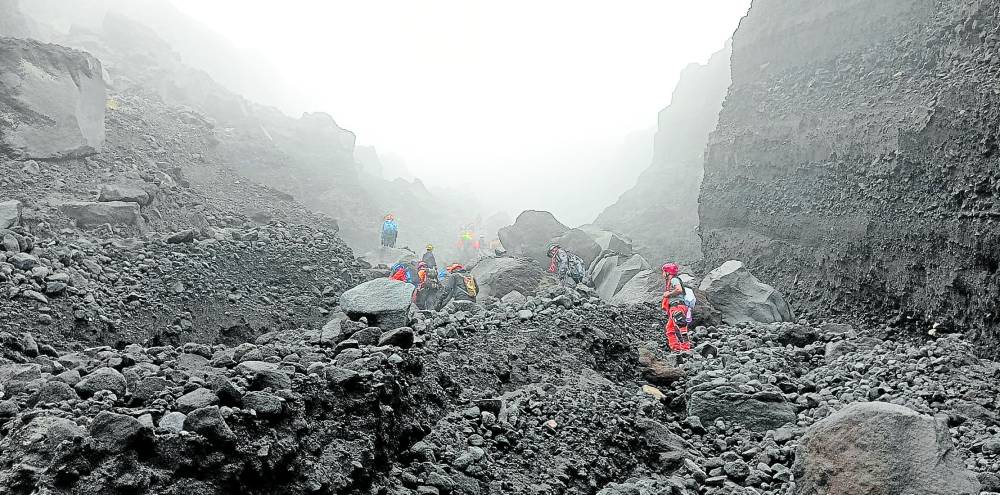Mayon’s tricky slopes, fog stall retrieval operation for plane crash victims’ remains

DANGEROUS TERRAIN The team of responders has suspended since Thursday afternoon the retrieval of the bodies of the four passenger of the ill-fated Cessna plane from the slopes of Mount Mayon due to heavy fog that has made it harder to navigate the volcano’s dangerous terrain, in this photo taken Friday. PHOTO COURTESY OF CESSNA 340A INCIDENT COMMAND POST
LEGAZPI CITY—Emergency responders started to drill holes into solid rocks at the gullies of Mayon Volcano on Friday to set up the anchor bolts that would aid in retrieving the bodies of the four people on board the Cessna plane that crashed on Feb. 18.
The teams reached the crash site on Wednesday but had difficulty carrying the bodies down due to the steep and dangerous terrain that limited their movement in the area where the plane went down, a steep slope about 350 meters from the crater.
On Friday afternoon, the teams recovered the personal belongings of the four victims, which were reportedly scattered at the crash site, according to Tim Lawrence Florece, information officer of the municipal government of Camalig.
Florece said the items were turned over to the Scene of the Crime Operatives of the local police for investigation.
Camalig Mayor Carlos Irwin Baldo Jr., the incident commander, said they augmented the teams at the site with persons who could help install anchors, bolts, ropes and safety lines needed by those who would be bringing down the bodies of the plane’s passengers.
Baldo said the responders had to trek back and forth to the crash site to take rest and continue with the retrieval operations. They set up a base camp located 1,000 m from the crash site.
‘Very dangerous’
“They have to rest in other areas. They can’t stay there (crash site) because it’s very dangerous. The area is very cold and [the ground] might erode,” Baldo added.
The team, composed of veteran local mountaineers, government rescuers and local guides, started to climb on Tuesday to the crash site, about 1,800 m (6,000 feet) from the base of the volcano.
They had to suspend the retrieval operations on Thursday afternoon due to poor visibility caused by heavy fog and the danger of moving on unstable ground and loose soil.
The Cessna RPC340 bound for Metro Manila went missing minutes after it took off from Bicol International Airport in Daraga, Albay, at 6:43 a.m. on Feb. 18.
At a press briefing on Thursday, Baldo confirmed that Capt. Rufino James Crisostomo Jr., the pilot; his mechanic, Joel Martin; and the two Australian passengers, Simon Chipperfield and Karthi Santhanam, were found dead at the crash site.
Their bodies were found near the wreckage and believed to have been blown out of the plane after a possible explosion.
Crisostomo and Martin were employees of the Energy Development Corp. (EDC), the largest geothermal energy producer in the Philippines, while the Australians were technical consultants of the company.
The EDC appealed to the public not to share images of the plane and its passengers on social media to show respect to their families and friends who were grieving.
“We stand united with the families in requesting that only good photos of the passengers from their public lives be shown,” EDC said in a statement on Friday.
It added: “We have released such photos to the media and through our social media pages to be used, for everyone to be reminded of the beautiful people that they are.”
Crisostomo had 30 years of professional experience as a pilot and worked with EDC for more than 12 years, the EDC said.
Frances Ariola, EDC’s head of corporate communications, said in a private message that the consultants visited the Bacon-Manito geothermal facility in Albay and Sorsogon provinces before the incident happened.
Ariola said the consultants also handled other geothermal facilities in Leyte, Negros and Mt. Apo.
The power plant in Tiwi, Albay, was not under the EDC, as earlier reported.
Another search
In Isabela province where another Cessna plane also went missing on Jan. 24, four tracker dogs caught the stench from what rescuers believed to be cadavers in an area some 500 m up the Sierra Madre mountain ranges in Divilacan town on Feb. 18, according to Constante Foronda, Isabela provincial disaster risk reduction and management officer.
But as of Friday, the wreckage of the Gen AV Cessna 206 plane or its six passengers had not been located.
At a previous press briefing, Foronda said the scent-sniffing dogs could be leading them closer to where the missing plane and its passengers were.
The search had been halted several times due to the inclement weather caused by a low pressure area affecting Luzon.
The six-seat aircraft went off radar on Jan. 24 while heading to Maconacon town, about 60 kilometers from Cauayan Domestic Airport, where it took off at 2:16 p.m.
It was carrying the pilot, Capt. Eleazar Joven, and passengers Val Kamatoy, Rom Joshtle Manaday, siblings Xam and Mark Eiron Seguerra, and Josefa Perla España.